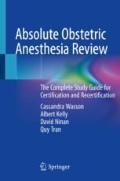Abstract
This chapter focuses on VBAC. It discusses the contraindications for VBCC and predictors for both successful and unsuccessful VBAC. It also discusses risks of VBAC, such as uterine rupture.
You have full access to this open access chapter, Download chapter PDF
Keywords
- Contraindications for VBAC
- Predictor for successful VBAC
- Predictors for unsuccessful VBAC
- Uterine rupture
- Blood management
-
1.
A Classic uterine incision is high risk for catastrophic uterine rupture during a subsequent pregnancy (both before or during labor) and increases maternal and perinatal morbidity or mortality
-
2.
Low-transverse uterine incision has less blood loss and better healing, with better maintenance of integrity in subsequent pregnancies
-
3.
Trial of labor is successful in 60–80% of women
-
4.
Previous successful vaginal delivery is the greatest predictor for successful VBAC
-
5.
History of dystocia, a need for induction of labor, and maternal obesity are associated with a lower likelihood of successful VBAC
-
6.
Contraindications for VBAC :
-
(a)
Previous classic or T-shaped incision or extensive transfundal uterine surgery
-
(b)
Previous uterine rupture
-
(c)
Medical or obstetric complication that precludes vaginal delivery
-
(d)
Inability to perform emergency cesarean delivery because of unavailable surgeon, anesthesia (provider), sufficient staff or facility
-
(e)
Two prior uterine scars and no vaginal deliveries
-
(a)
-
7.
All VBAC patients should be type-and-crossed
-
8.
Epidural analgesia does not delay the diagnosis of uterine rupture or decrease the likelihood of successful VBAC
Author information
Authors and Affiliations
Rights and permissions
Copyright information
© 2019 Springer Nature Switzerland AG
About this chapter
Cite this chapter
Wasson, C., Kelly, A., Ninan, D., Tran, Q. (2019). Vaginal Birth After Cesarean Section (VBAC). In: Absolute Obstetric Anesthesia Review. Springer, Cham. https://doi.org/10.1007/978-3-319-96980-0_57
Download citation
DOI: https://doi.org/10.1007/978-3-319-96980-0_57
Published:
Publisher Name: Springer, Cham
Print ISBN: 978-3-319-96979-4
Online ISBN: 978-3-319-96980-0
eBook Packages: MedicineMedicine (R0)

